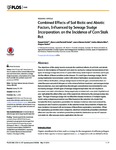Por favor, use este identificador para citar o enlazar este ítem:
http://www.alice.cnptia.embrapa.br/alice/handle/doc/1056444Registro completo de metadatos
| Campo DC | Valor | Lengua/Idioma |
|---|---|---|
| dc.contributor.author | GHINI, R. | pt_BR |
| dc.contributor.author | FORTES, N. L. P. | pt_BR |
| dc.contributor.author | NAVAS-CORTES, J. A. | pt_BR |
| dc.contributor.author | SILVA, C. A. | pt_BR |
| dc.contributor.author | BETTIOL, W. | pt_BR |
| dc.date.accessioned | 2016-11-16T11:11:11Z | pt_BR |
| dc.date.available | 2016-11-16T11:11:11Z | pt_BR |
| dc.date.created | 2016-11-16 | pt_BR |
| dc.date.issued | 2016 | pt_BR |
| dc.identifier.citation | Plos One, San Francisco, v. 11, n. 5, 17 p., e0155536, 2016. | pt_BR |
| dc.identifier.uri | http://www.alice.cnptia.embrapa.br/alice/handle/doc/1056444 | pt_BR |
| dc.description | Abstract: The objectives of this study were to evaluate the combined effects of soil bioticand abiotic factors on the incidence of Fusarium corn stalk rot, during four annual incorporations of two typesofsewagesludge intosoil ina 5-years field assay under tropical conditions and topredict the effectsof these variables on the disease. For each type of sewage sludge, the following treatments were included: control with mineral fertilization recommended for corn; control without fertilization; sewage sludge based on the nitrogen concentration that provided the same amount of nitrogen as in the mineral fertilizer treatment; and sewage sludge that provided two, four and eight times the nitrogen concentration recommended for corn. Increasing dosages of both types of sewage sludge incorporated into soil resulted in increased corn stalk rot incidence, being negatively correlated with corn yield. A global analysis highlighted the effect of the year of the experiment, followed by the sewage sludge dosages. The type of sewage sludge did not affect the disease incidence. Amultiple logistic model using a stepwise procedure was fitted based on the selection of a model that included the three explanatory parameters for disease incidence: electrical conductivity, magnesium and Fusarium population. In the selected model, the probability of higher disease incidence increased with an increase of these three explanatory parameters. When the explanatory parameters were compared, electrical conductivity presented a dominant effect and was the main variable to predict the probability distribution curves of Fusarium corn stalk rot, after sewage sludge application into the soil. | pt_BR |
| dc.language.iso | eng | eng |
| dc.rights | openAccess | eng |
| dc.title | Combined effects of soil biotic and abiotic factors, influenced by sewage sludge incorporation, on the incidence of corn stalk rot. | pt_BR |
| dc.type | Artigo de periódico | pt_BR |
| dc.date.updated | 2016-11-16T11:11:11Z | pt_BR |
| dc.subject.thesagro | Podridão do caule | pt_BR |
| dc.subject.thesagro | Fusarium | pt_BR |
| dc.subject.thesagro | Milho | pt_BR |
| dc.subject.thesagro | Solo | pt_BR |
| dc.subject.thesagro | Adubo de esgoto | pt_BR |
| dc.subject.thesagro | Lodo residual | pt_BR |
| dc.subject.thesagro | Doença de planta | pt_BR |
| dc.subject.nalthesaurus | Corn | pt_BR |
| dc.subject.nalthesaurus | Stem rot | pt_BR |
| dc.subject.nalthesaurus | Soil amendments | pt_BR |
| dc.subject.nalthesaurus | Sewage sludge | pt_BR |
| dc.subject.nalthesaurus | Plant diseases and disorders | pt_BR |
| riaa.ainfo.id | 1056444 | pt_BR |
| riaa.ainfo.lastupdate | 2016-11-16 | pt_BR |
| dc.contributor.institution | RAQUEL GHINI, CNPMA; NARA LUCIA PERONDI FORTES, UNIVERSIDADE DE TAUBATÉ; JUAN A NAVAS-CORTES, Instituto de Agricultura Sostenible; CARLOS ALBERTO SILVA, UFLA; WAGNER BETTIOL, CNPMA. | pt_BR |
| Aparece en las colecciones: | Artigo em periódico indexado (CNPMA)  | |
Ficheros en este ítem:
| Fichero | Descripción | Tamaño | Formato | |
|---|---|---|---|---|
| 2016AP10.PDF | 1,79 MB | Adobe PDF |  Visualizar/Abrir |









